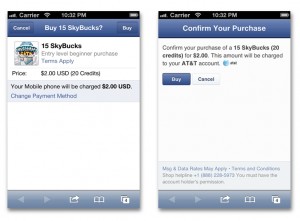
Gone are the days of Facebook’s freewheeling approach to launching and implementing new features without a concrete strategy for monetization. The post-IPO landscape is dotted with investors demanding ROI, leaving Facebook in a perpetual struggle to find new avenues for revenue sources. Despite the controversy of Facebook ads efficacy, a recent ComScore study helped to alleviate skeptics and anxious investors’ concerns. See our weekly roll-up for a collection of articles on the topic.
Mobilize or Perish
Zuckerberg admitted that Facebook missed the mobile bus, and is now scrambling to catch up. More users now access Facebook via their mobile devices than desktop or laptops, and those eyeballs need to be converted into revenue in order for Facebook to have a viable future. Given the smaller real estate on mobile devices, Facebook will have to balance how the ads are served and possibly redefine what an ad looks like.
One example that is an elegant solution for delivering a seamless user experience while giving advertisers a deeper level of control is the launch of Sponsored Stories, which I covered in an earlier Facebook Advanced article. While the fear that user’s streams may be taken over by brands willing to pay the highest dollar is not unfounded, the hope that the new option for marketers to buy Sponsored Stories that are separately targeted to mobile-only will provide marketers with an opportunity to segment their audience for better-targeted ad placements. The ability to place Sponsored Stories in a number of places on a number of devices in a separate manner also provides more accurate data in terms of their efficacy at driving action, and further, whether that action can be monetized.
But I want it NOW!

As mobile web use continues to skyrocket, marketers and developers are scrambling to optimize their websites and landing pages for the mobile experience. In the age of one-click social sign-ins, consumers’ tolerance for lengthy forms and multi-step processes for digital interactions is quickly waning. Facebook updated their mobile payments process for mobile Web applications that now allows users to complete their purchase in 2 steps instead of the previous 7-step method. This should greatly reduce bounce rates and has positive implications for m-commerce, non-profits, app developers and more.
Location is money
Serving ads to consumers when they are near their place of purchase is an incredible opportunity for brands, retailers and restaurants, provided consumers don’t feel like Big Brother is always watching and listening. The power of SoLoMo (Social/Local/Mobile) and Facebook is that the platform leverages the massive database of personal information to serve ads based on a number of criteria beyond your location and mobile device. Mobile ads only accounted for 1 percent of all ad spending in 2011, and is expected to grow 80 percent to $2.61 billion this year. While Google received half on those ad dollars in 2011, Facebook continues to eye Google’s pie in 2012.
Children are the future
Facebook has been considering opening up the social network to permit children younger than 13 to access the platform. This piqued the interest of Facebook Advertising agency, TBG Digital, who worked with a number of large clients, including JetBlue and Coca-Cola, who analyzed over 170 million ad impressions to compare cost-per-click (CPC) and click-through-rates (CTR) of users between the age of 13 and 15 and users over the age of 16. They found that users over the age of 16 had a CPC rate that was twice as high as users between the age of 13 and 15. While there are fewer products available to market to a younger age group, the lower cost associated with targeting this younger audience makes this a highly attractive segment for advertisers. The younger consumer is more likely to interact with mobile ads as they are often most comfortable in the mobile environment. However, there are some ethical issues as some children’s advocate groups are often against any children participating on the platform, with advertisers often viewed as the most nefarious of marketers using predatory ad-tactics to take advantage of influential minds that are not yet fully developed.
One compromise to this dilemma could be to refrain from serving young children ads, but to still leverage their personal data to serve more relevant ads to their parent or guardian (think location-based ads serving Toys R Us sale coupons or McDonald’s Fantastic Four Happy Meal specials to the Mom’s phone when running errands together). However, there are still some considerations related to gathering any data with young children who may not fully understand consent.
Help us iOS 6; you’re our only hope!

One of the biggest boons for the rapid growth and mainstream adoption of Twitter was the deep integration of the platform in iOS5. When Twitter was first introduced to iOS 5 last year, the number of Apple users who also use Twitter tripled, with 47% of all photo on Twitter being generated from an Apple device. While Facebook does not have as much room to grow in terms of collecting a larger user-base, they can always improve the amount of content that is shared, and capitalize (and monetize) the subsequent data that is collected. There are some concerns that this could result in over-sharing or friction-less-sharing-gone-bad incidents, but this should lead Facebook to create controls that make it easier for mobile users to manage their Facebook interactions and sharing habits. The social feedback that is generated from user interaction will hopefully also provide Facebook with new analytics to further enhance the user experience by identifying content that is relevant to users (i.e.; the number of times an app is shared or liked on iTunes). Facebook will have to get the mix right, or users will be reaching for the mute of logout button as a deluge of Apple fans start sharing more than ever after the release of iOS 6.
What do you think about Facebook’s mobile approach? Do they have what it takes to last another decade?



Sorry, the comment form is closed at this time.